Analysis of the Australian NBN Project Failure Report
VerifiedAdded on 2022/09/28
|16
|4189
|37
Report
AI Summary
This report provides a comprehensive analysis of the Australian National Broadband Network (NBN) project failure. It examines the project's initial goals and the shift from FTTP to FTTN technology, highlighting how these changes contributed to the project's complexity and ultimate failure. The report delves into the range of control systems used, assessing their ineffectiveness in managing costs, schedules, scope, and quality. It dissects the causes of significant time and cost overruns, attributing them to factors such as ignored early warnings, scope changes, and inadequate planning. The analysis extends to the ineffectiveness of the project team, pinpointing issues like low engagement, communication breakdowns, and a lack of understanding of project management best practices. Furthermore, the report explores the impact of stakeholder needs on the project's trajectory and evaluates the project management actions that could have prevented the NBN's collapse. The conclusion offers recommendations based on the analysis of different project management activities that could have ensured the NBN project's success, providing valuable lessons for future infrastructure projects.

Running head: PM
Executing and Closing Project
Name of Student
Name of University
Author Note
Executing and Closing Project
Name of Student
Name of University
Author Note
Paraphrase This Document
Need a fresh take? Get an instant paraphrase of this document with our AI Paraphraser

1
PM
Table of Contents
1. Introduction to the Failed Project....................................................................................2
2. Understanding of the range of Control systems used......................................................2
3. Analyzing the causes of time and cost overrun...............................................................4
3.1. Analysis of the Cost Overrun...................................................................................4
3.2. Analysis of the Schedule Overrun............................................................................5
4. Analysis of the ineffectiveness of Project Team.............................................................6
5. Analysis of the Problems and the stakeholders’ Needs...................................................8
6. Analysis of the Project Management Actions.................................................................9
7. Conclusion.....................................................................................................................11
References..........................................................................................................................12
PM
Table of Contents
1. Introduction to the Failed Project....................................................................................2
2. Understanding of the range of Control systems used......................................................2
3. Analyzing the causes of time and cost overrun...............................................................4
3.1. Analysis of the Cost Overrun...................................................................................4
3.2. Analysis of the Schedule Overrun............................................................................5
4. Analysis of the ineffectiveness of Project Team.............................................................6
5. Analysis of the Problems and the stakeholders’ Needs...................................................8
6. Analysis of the Project Management Actions.................................................................9
7. Conclusion.....................................................................................................................11
References..........................................................................................................................12
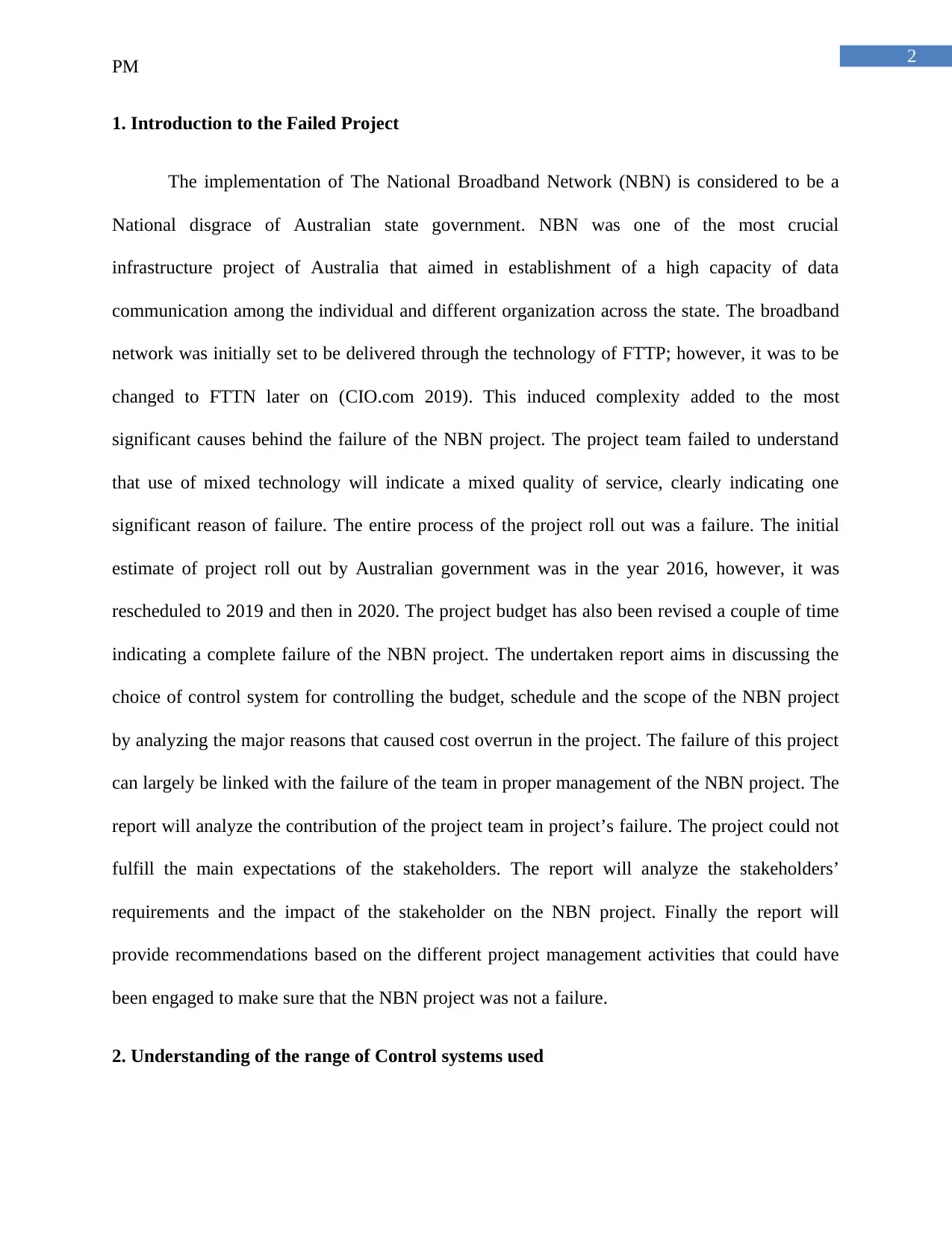
2
PM
1. Introduction to the Failed Project
The implementation of The National Broadband Network (NBN) is considered to be a
National disgrace of Australian state government. NBN was one of the most crucial
infrastructure project of Australia that aimed in establishment of a high capacity of data
communication among the individual and different organization across the state. The broadband
network was initially set to be delivered through the technology of FTTP; however, it was to be
changed to FTTN later on (CIO.com 2019). This induced complexity added to the most
significant causes behind the failure of the NBN project. The project team failed to understand
that use of mixed technology will indicate a mixed quality of service, clearly indicating one
significant reason of failure. The entire process of the project roll out was a failure. The initial
estimate of project roll out by Australian government was in the year 2016, however, it was
rescheduled to 2019 and then in 2020. The project budget has also been revised a couple of time
indicating a complete failure of the NBN project. The undertaken report aims in discussing the
choice of control system for controlling the budget, schedule and the scope of the NBN project
by analyzing the major reasons that caused cost overrun in the project. The failure of this project
can largely be linked with the failure of the team in proper management of the NBN project. The
report will analyze the contribution of the project team in project’s failure. The project could not
fulfill the main expectations of the stakeholders. The report will analyze the stakeholders’
requirements and the impact of the stakeholder on the NBN project. Finally the report will
provide recommendations based on the different project management activities that could have
been engaged to make sure that the NBN project was not a failure.
2. Understanding of the range of Control systems used
PM
1. Introduction to the Failed Project
The implementation of The National Broadband Network (NBN) is considered to be a
National disgrace of Australian state government. NBN was one of the most crucial
infrastructure project of Australia that aimed in establishment of a high capacity of data
communication among the individual and different organization across the state. The broadband
network was initially set to be delivered through the technology of FTTP; however, it was to be
changed to FTTN later on (CIO.com 2019). This induced complexity added to the most
significant causes behind the failure of the NBN project. The project team failed to understand
that use of mixed technology will indicate a mixed quality of service, clearly indicating one
significant reason of failure. The entire process of the project roll out was a failure. The initial
estimate of project roll out by Australian government was in the year 2016, however, it was
rescheduled to 2019 and then in 2020. The project budget has also been revised a couple of time
indicating a complete failure of the NBN project. The undertaken report aims in discussing the
choice of control system for controlling the budget, schedule and the scope of the NBN project
by analyzing the major reasons that caused cost overrun in the project. The failure of this project
can largely be linked with the failure of the team in proper management of the NBN project. The
report will analyze the contribution of the project team in project’s failure. The project could not
fulfill the main expectations of the stakeholders. The report will analyze the stakeholders’
requirements and the impact of the stakeholder on the NBN project. Finally the report will
provide recommendations based on the different project management activities that could have
been engaged to make sure that the NBN project was not a failure.
2. Understanding of the range of Control systems used
⊘ This is a preview!⊘
Do you want full access?
Subscribe today to unlock all pages.

Trusted by 1+ million students worldwide
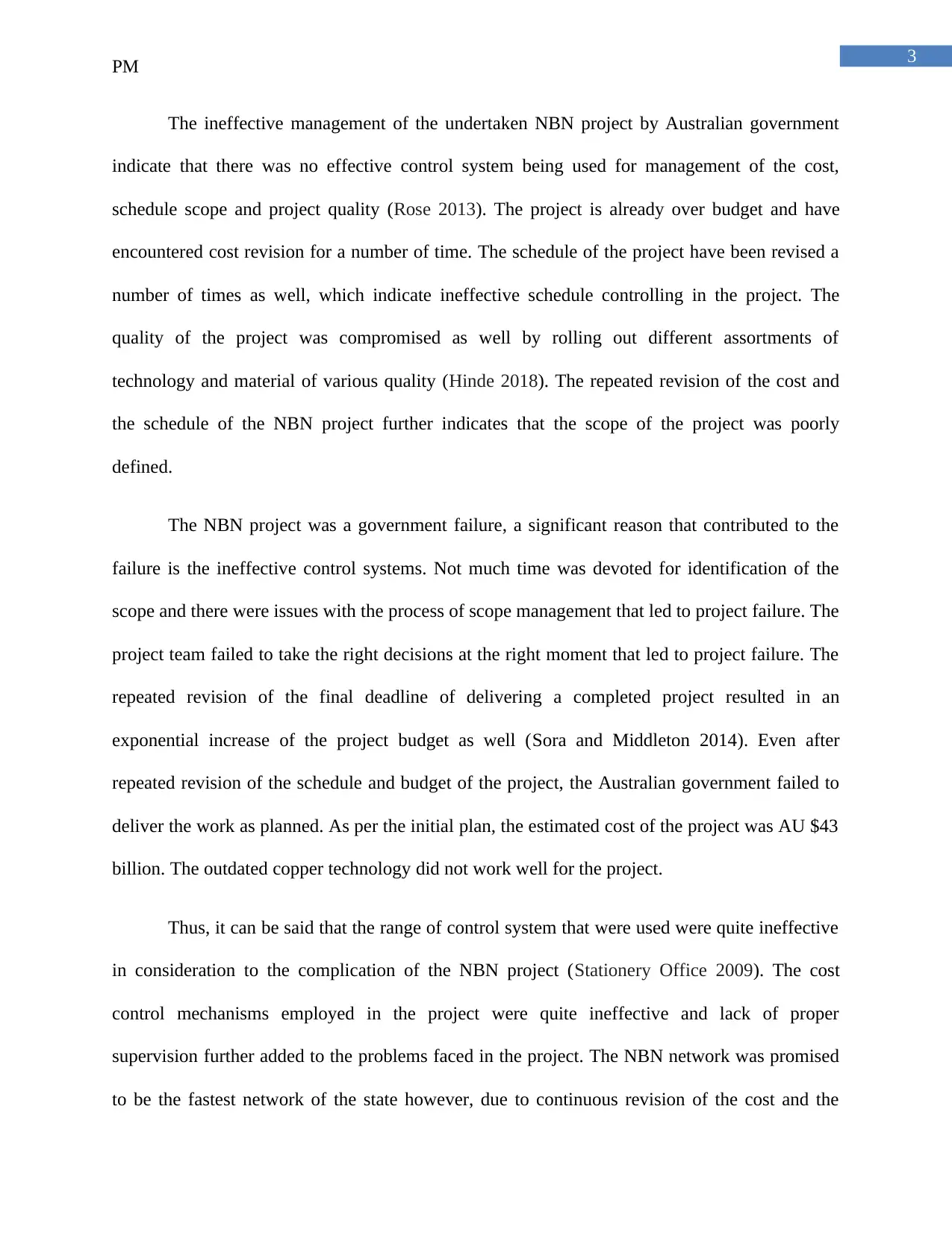
3
PM
The ineffective management of the undertaken NBN project by Australian government
indicate that there was no effective control system being used for management of the cost,
schedule scope and project quality (Rose 2013). The project is already over budget and have
encountered cost revision for a number of time. The schedule of the project have been revised a
number of times as well, which indicate ineffective schedule controlling in the project. The
quality of the project was compromised as well by rolling out different assortments of
technology and material of various quality (Hinde 2018). The repeated revision of the cost and
the schedule of the NBN project further indicates that the scope of the project was poorly
defined.
The NBN project was a government failure, a significant reason that contributed to the
failure is the ineffective control systems. Not much time was devoted for identification of the
scope and there were issues with the process of scope management that led to project failure. The
project team failed to take the right decisions at the right moment that led to project failure. The
repeated revision of the final deadline of delivering a completed project resulted in an
exponential increase of the project budget as well (Sora and Middleton 2014). Even after
repeated revision of the schedule and budget of the project, the Australian government failed to
deliver the work as planned. As per the initial plan, the estimated cost of the project was AU $43
billion. The outdated copper technology did not work well for the project.
Thus, it can be said that the range of control system that were used were quite ineffective
in consideration to the complication of the NBN project (Stationery Office 2009). The cost
control mechanisms employed in the project were quite ineffective and lack of proper
supervision further added to the problems faced in the project. The NBN network was promised
to be the fastest network of the state however, due to continuous revision of the cost and the
PM
The ineffective management of the undertaken NBN project by Australian government
indicate that there was no effective control system being used for management of the cost,
schedule scope and project quality (Rose 2013). The project is already over budget and have
encountered cost revision for a number of time. The schedule of the project have been revised a
number of times as well, which indicate ineffective schedule controlling in the project. The
quality of the project was compromised as well by rolling out different assortments of
technology and material of various quality (Hinde 2018). The repeated revision of the cost and
the schedule of the NBN project further indicates that the scope of the project was poorly
defined.
The NBN project was a government failure, a significant reason that contributed to the
failure is the ineffective control systems. Not much time was devoted for identification of the
scope and there were issues with the process of scope management that led to project failure. The
project team failed to take the right decisions at the right moment that led to project failure. The
repeated revision of the final deadline of delivering a completed project resulted in an
exponential increase of the project budget as well (Sora and Middleton 2014). Even after
repeated revision of the schedule and budget of the project, the Australian government failed to
deliver the work as planned. As per the initial plan, the estimated cost of the project was AU $43
billion. The outdated copper technology did not work well for the project.
Thus, it can be said that the range of control system that were used were quite ineffective
in consideration to the complication of the NBN project (Stationery Office 2009). The cost
control mechanisms employed in the project were quite ineffective and lack of proper
supervision further added to the problems faced in the project. The NBN network was promised
to be the fastest network of the state however, due to continuous revision of the cost and the
Paraphrase This Document
Need a fresh take? Get an instant paraphrase of this document with our AI Paraphraser

4
PM
schedule of the NBN project the project could not be completed as expected. The quality of the
project could not meet the expectations as after the initial roll out, more than 54000 people who
were connected to NBN could not even attain the minimum guaranteed speed of 25 Mbps. Thus,
the control systems adopted for cost, scope, schedule and quality failed to keep the NBN project
on track leading to failure of this critical infrastructure project of Australia.
3. Analyzing the causes of time and cost overrun
The main explanations behind failure of the NBN project accounts to uncontrolled
schedule and cost overrun. This part of the report will try to analyze the main reasons that
contributed to the schedule and cost overrun of the NBN project. In the following subsections,
the main reasons or the factors that contributes to the budget and schedule overrun in the NBN
project of Australia are discussed.
3.1. Analysis of the Cost Overrun
The main reasons of cost overrun in the project was that the early signs of excessive
delays and the cost blowouts in the project were ignored. The excessive slippage of the
timeframe allocated for each task, along with a higher operating expenditure contributed to the
disaster of the project. During the initial stages of the NBN project, it was identified that in
comparison to the initial plan that was developed, a higher operating cost was incurred by the
project (Pinto and Mantel 1990). The repeated change in the project’s scope along with the
revision in the project schedule resulted in cost overrun in the project (Parker, Parsons and
Isharyanto 2015). The main aim of the NBN project was to deliver a cheaper broadband service
to the users. However, the dual cost blowout has led to the complete failure of the NBN project
(Serra and Kunc 2015). The cost of the project was first revised from $29.5 billion to $41 billion
PM
schedule of the NBN project the project could not be completed as expected. The quality of the
project could not meet the expectations as after the initial roll out, more than 54000 people who
were connected to NBN could not even attain the minimum guaranteed speed of 25 Mbps. Thus,
the control systems adopted for cost, scope, schedule and quality failed to keep the NBN project
on track leading to failure of this critical infrastructure project of Australia.
3. Analyzing the causes of time and cost overrun
The main explanations behind failure of the NBN project accounts to uncontrolled
schedule and cost overrun. This part of the report will try to analyze the main reasons that
contributed to the schedule and cost overrun of the NBN project. In the following subsections,
the main reasons or the factors that contributes to the budget and schedule overrun in the NBN
project of Australia are discussed.
3.1. Analysis of the Cost Overrun
The main reasons of cost overrun in the project was that the early signs of excessive
delays and the cost blowouts in the project were ignored. The excessive slippage of the
timeframe allocated for each task, along with a higher operating expenditure contributed to the
disaster of the project. During the initial stages of the NBN project, it was identified that in
comparison to the initial plan that was developed, a higher operating cost was incurred by the
project (Pinto and Mantel 1990). The repeated change in the project’s scope along with the
revision in the project schedule resulted in cost overrun in the project (Parker, Parsons and
Isharyanto 2015). The main aim of the NBN project was to deliver a cheaper broadband service
to the users. However, the dual cost blowout has led to the complete failure of the NBN project
(Serra and Kunc 2015). The cost of the project was first revised from $29.5 billion to $41 billion

5
PM
and in the last year, the cost of the project went up to $56 billion, which was way more than the
initially estimated project cost.
3.2. Analysis of the Schedule Overrun
The NBN project of Australia is found to a classic example of project disaster with
controllable blown out of the cost and the schedule of the project. The ineffective scope
identification and scope management contributed to the repeated schedule revision in the NBN
project (Li 2012). Association of a greater number stakeholders in the NBN project has resulted
in change and revision of the scope of the project which ultimately contributed to the project
failure. Spending on a well-planned infrastructure although was good, the first consideration for
the same should have been effective planning. The lack of effective planning and realistic
schedule estimation contributed to the project’s failure. Furthermore, the project team was quite
ineffective in identification of the present problems in the project implementation approach and
fix the project scope. The works that were needed to be done were not clear in the project plan,
that ultimately contributed in its failure (Kerzner 2017). One most critical consideration of
planning and management of a project involves development of a realistic plan that will be
followed by the project team to execute the NBN project as planned. The ineffectiveness of the
project manager in accurate schedule estimation and budget estimation of the project resulted in
continuous budget revision throughout the accomplishment of the NBN project (Meredith,
Mantel Jr and Shafer 2017). The project team further failed in understanding the necessities and
the priorities of the project resulting in failure of the undertaken project. The main motive behind
the repeated revision of the schedule of the project was that the project team did not know where
the plan made would take them and this was a result of ineffective scope identification
(Marcelino-Sádaba, et al. 2014). Thus, improper identification of the scope of the NBN project
PM
and in the last year, the cost of the project went up to $56 billion, which was way more than the
initially estimated project cost.
3.2. Analysis of the Schedule Overrun
The NBN project of Australia is found to a classic example of project disaster with
controllable blown out of the cost and the schedule of the project. The ineffective scope
identification and scope management contributed to the repeated schedule revision in the NBN
project (Li 2012). Association of a greater number stakeholders in the NBN project has resulted
in change and revision of the scope of the project which ultimately contributed to the project
failure. Spending on a well-planned infrastructure although was good, the first consideration for
the same should have been effective planning. The lack of effective planning and realistic
schedule estimation contributed to the project’s failure. Furthermore, the project team was quite
ineffective in identification of the present problems in the project implementation approach and
fix the project scope. The works that were needed to be done were not clear in the project plan,
that ultimately contributed in its failure (Kerzner 2017). One most critical consideration of
planning and management of a project involves development of a realistic plan that will be
followed by the project team to execute the NBN project as planned. The ineffectiveness of the
project manager in accurate schedule estimation and budget estimation of the project resulted in
continuous budget revision throughout the accomplishment of the NBN project (Meredith,
Mantel Jr and Shafer 2017). The project team further failed in understanding the necessities and
the priorities of the project resulting in failure of the undertaken project. The main motive behind
the repeated revision of the schedule of the project was that the project team did not know where
the plan made would take them and this was a result of ineffective scope identification
(Marcelino-Sádaba, et al. 2014). Thus, improper identification of the scope of the NBN project
⊘ This is a preview!⊘
Do you want full access?
Subscribe today to unlock all pages.

Trusted by 1+ million students worldwide
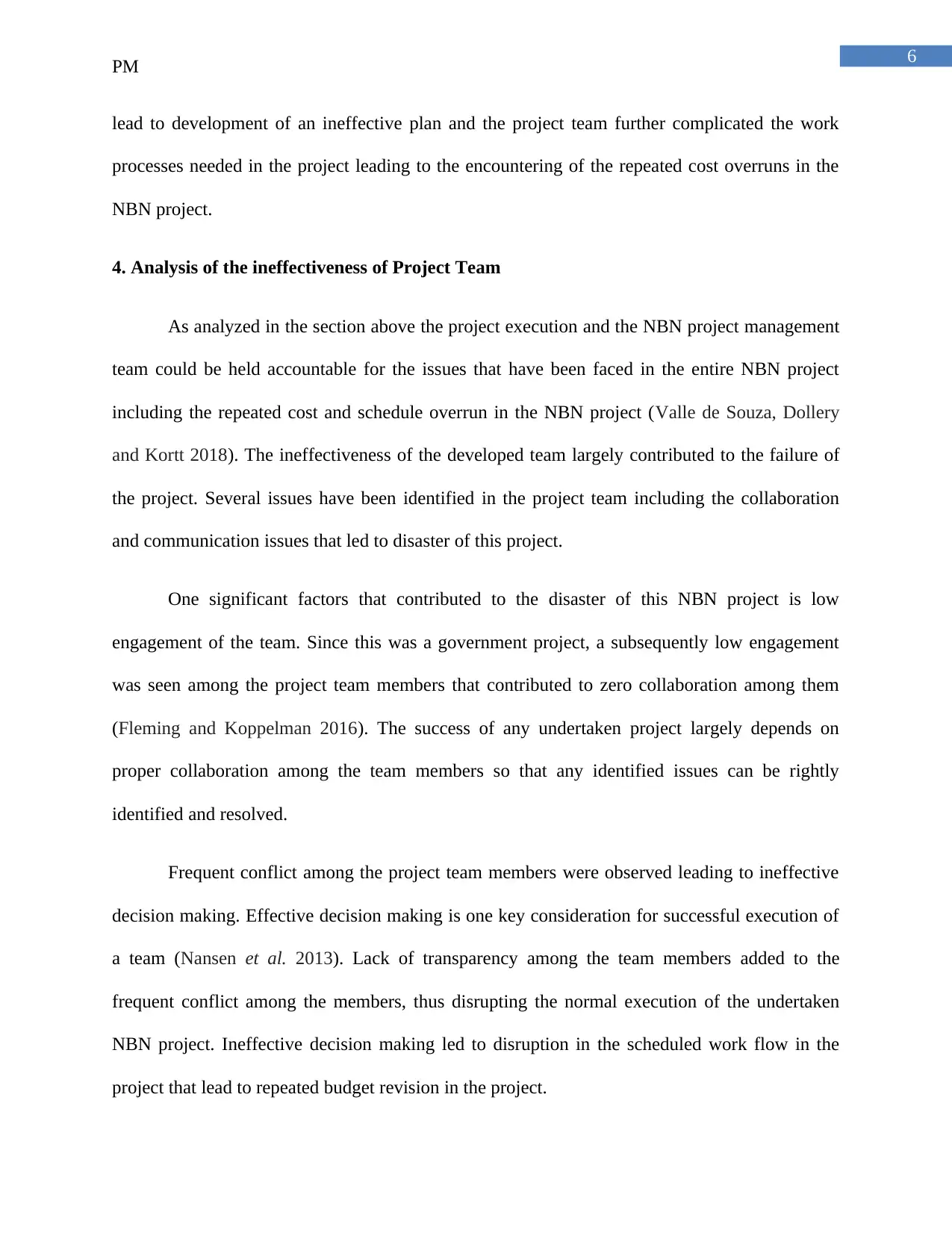
6
PM
lead to development of an ineffective plan and the project team further complicated the work
processes needed in the project leading to the encountering of the repeated cost overruns in the
NBN project.
4. Analysis of the ineffectiveness of Project Team
As analyzed in the section above the project execution and the NBN project management
team could be held accountable for the issues that have been faced in the entire NBN project
including the repeated cost and schedule overrun in the NBN project (Valle de Souza, Dollery
and Kortt 2018). The ineffectiveness of the developed team largely contributed to the failure of
the project. Several issues have been identified in the project team including the collaboration
and communication issues that led to disaster of this project.
One significant factors that contributed to the disaster of this NBN project is low
engagement of the team. Since this was a government project, a subsequently low engagement
was seen among the project team members that contributed to zero collaboration among them
(Fleming and Koppelman 2016). The success of any undertaken project largely depends on
proper collaboration among the team members so that any identified issues can be rightly
identified and resolved.
Frequent conflict among the project team members were observed leading to ineffective
decision making. Effective decision making is one key consideration for successful execution of
a team (Nansen et al. 2013). Lack of transparency among the team members added to the
frequent conflict among the members, thus disrupting the normal execution of the undertaken
NBN project. Ineffective decision making led to disruption in the scheduled work flow in the
project that lead to repeated budget revision in the project.
PM
lead to development of an ineffective plan and the project team further complicated the work
processes needed in the project leading to the encountering of the repeated cost overruns in the
NBN project.
4. Analysis of the ineffectiveness of Project Team
As analyzed in the section above the project execution and the NBN project management
team could be held accountable for the issues that have been faced in the entire NBN project
including the repeated cost and schedule overrun in the NBN project (Valle de Souza, Dollery
and Kortt 2018). The ineffectiveness of the developed team largely contributed to the failure of
the project. Several issues have been identified in the project team including the collaboration
and communication issues that led to disaster of this project.
One significant factors that contributed to the disaster of this NBN project is low
engagement of the team. Since this was a government project, a subsequently low engagement
was seen among the project team members that contributed to zero collaboration among them
(Fleming and Koppelman 2016). The success of any undertaken project largely depends on
proper collaboration among the team members so that any identified issues can be rightly
identified and resolved.
Frequent conflict among the project team members were observed leading to ineffective
decision making. Effective decision making is one key consideration for successful execution of
a team (Nansen et al. 2013). Lack of transparency among the team members added to the
frequent conflict among the members, thus disrupting the normal execution of the undertaken
NBN project. Ineffective decision making led to disruption in the scheduled work flow in the
project that lead to repeated budget revision in the project.
Paraphrase This Document
Need a fresh take? Get an instant paraphrase of this document with our AI Paraphraser
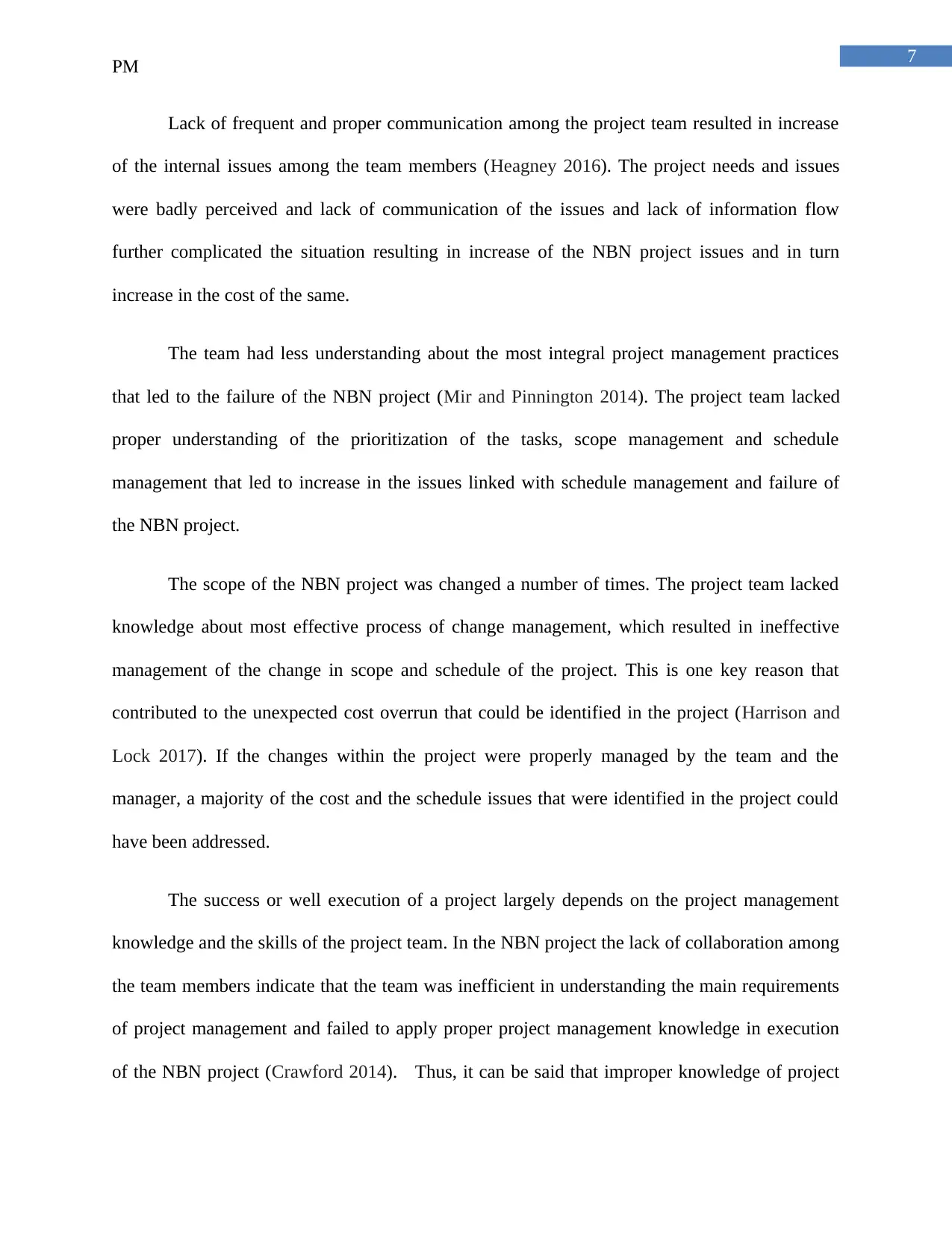
7
PM
Lack of frequent and proper communication among the project team resulted in increase
of the internal issues among the team members (Heagney 2016). The project needs and issues
were badly perceived and lack of communication of the issues and lack of information flow
further complicated the situation resulting in increase of the NBN project issues and in turn
increase in the cost of the same.
The team had less understanding about the most integral project management practices
that led to the failure of the NBN project (Mir and Pinnington 2014). The project team lacked
proper understanding of the prioritization of the tasks, scope management and schedule
management that led to increase in the issues linked with schedule management and failure of
the NBN project.
The scope of the NBN project was changed a number of times. The project team lacked
knowledge about most effective process of change management, which resulted in ineffective
management of the change in scope and schedule of the project. This is one key reason that
contributed to the unexpected cost overrun that could be identified in the project (Harrison and
Lock 2017). If the changes within the project were properly managed by the team and the
manager, a majority of the cost and the schedule issues that were identified in the project could
have been addressed.
The success or well execution of a project largely depends on the project management
knowledge and the skills of the project team. In the NBN project the lack of collaboration among
the team members indicate that the team was inefficient in understanding the main requirements
of project management and failed to apply proper project management knowledge in execution
of the NBN project (Crawford 2014). Thus, it can be said that improper knowledge of project
PM
Lack of frequent and proper communication among the project team resulted in increase
of the internal issues among the team members (Heagney 2016). The project needs and issues
were badly perceived and lack of communication of the issues and lack of information flow
further complicated the situation resulting in increase of the NBN project issues and in turn
increase in the cost of the same.
The team had less understanding about the most integral project management practices
that led to the failure of the NBN project (Mir and Pinnington 2014). The project team lacked
proper understanding of the prioritization of the tasks, scope management and schedule
management that led to increase in the issues linked with schedule management and failure of
the NBN project.
The scope of the NBN project was changed a number of times. The project team lacked
knowledge about most effective process of change management, which resulted in ineffective
management of the change in scope and schedule of the project. This is one key reason that
contributed to the unexpected cost overrun that could be identified in the project (Harrison and
Lock 2017). If the changes within the project were properly managed by the team and the
manager, a majority of the cost and the schedule issues that were identified in the project could
have been addressed.
The success or well execution of a project largely depends on the project management
knowledge and the skills of the project team. In the NBN project the lack of collaboration among
the team members indicate that the team was inefficient in understanding the main requirements
of project management and failed to apply proper project management knowledge in execution
of the NBN project (Crawford 2014). Thus, it can be said that improper knowledge of project
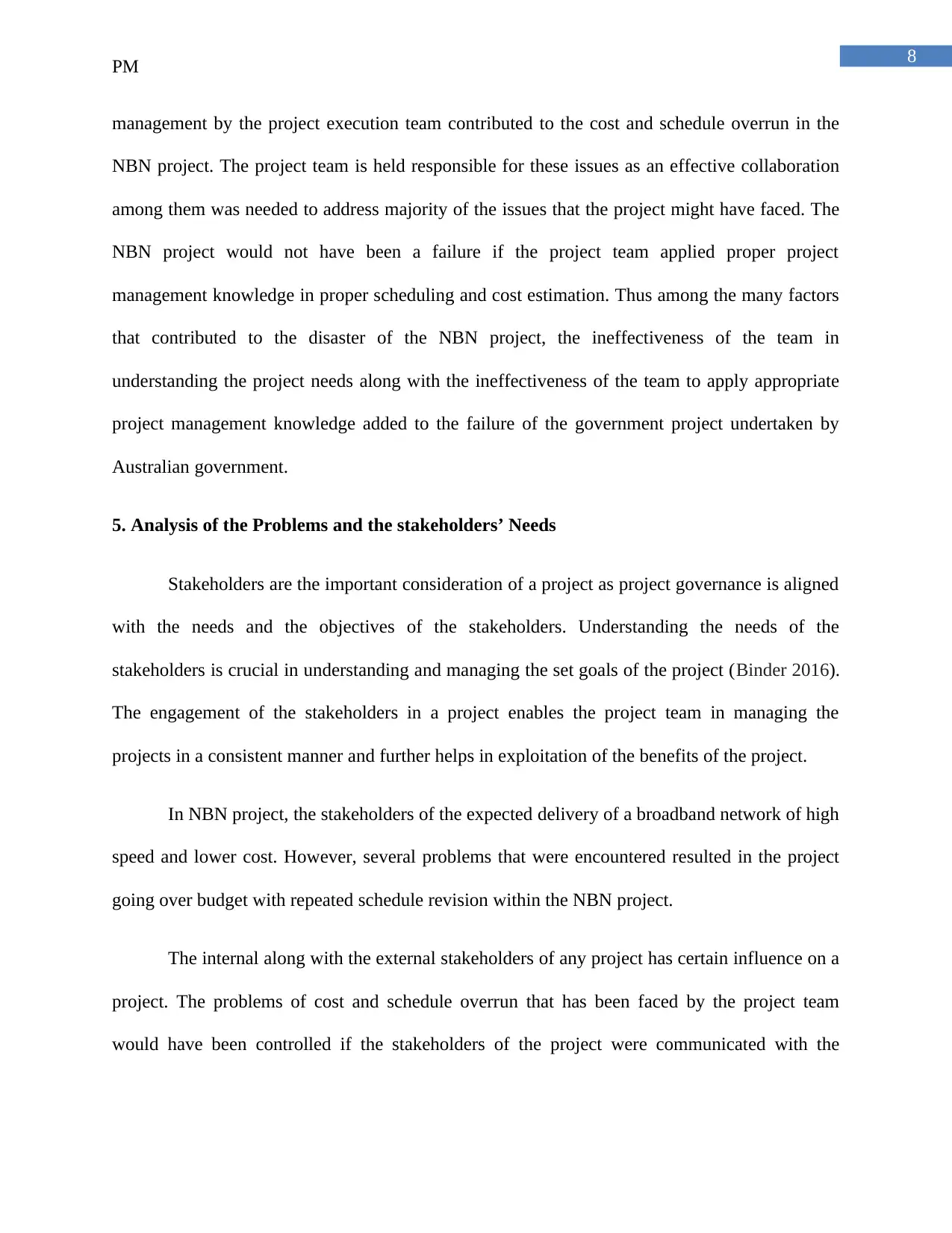
8
PM
management by the project execution team contributed to the cost and schedule overrun in the
NBN project. The project team is held responsible for these issues as an effective collaboration
among them was needed to address majority of the issues that the project might have faced. The
NBN project would not have been a failure if the project team applied proper project
management knowledge in proper scheduling and cost estimation. Thus among the many factors
that contributed to the disaster of the NBN project, the ineffectiveness of the team in
understanding the project needs along with the ineffectiveness of the team to apply appropriate
project management knowledge added to the failure of the government project undertaken by
Australian government.
5. Analysis of the Problems and the stakeholders’ Needs
Stakeholders are the important consideration of a project as project governance is aligned
with the needs and the objectives of the stakeholders. Understanding the needs of the
stakeholders is crucial in understanding and managing the set goals of the project (Binder 2016).
The engagement of the stakeholders in a project enables the project team in managing the
projects in a consistent manner and further helps in exploitation of the benefits of the project.
In NBN project, the stakeholders of the expected delivery of a broadband network of high
speed and lower cost. However, several problems that were encountered resulted in the project
going over budget with repeated schedule revision within the NBN project.
The internal along with the external stakeholders of any project has certain influence on a
project. The problems of cost and schedule overrun that has been faced by the project team
would have been controlled if the stakeholders of the project were communicated with the
PM
management by the project execution team contributed to the cost and schedule overrun in the
NBN project. The project team is held responsible for these issues as an effective collaboration
among them was needed to address majority of the issues that the project might have faced. The
NBN project would not have been a failure if the project team applied proper project
management knowledge in proper scheduling and cost estimation. Thus among the many factors
that contributed to the disaster of the NBN project, the ineffectiveness of the team in
understanding the project needs along with the ineffectiveness of the team to apply appropriate
project management knowledge added to the failure of the government project undertaken by
Australian government.
5. Analysis of the Problems and the stakeholders’ Needs
Stakeholders are the important consideration of a project as project governance is aligned
with the needs and the objectives of the stakeholders. Understanding the needs of the
stakeholders is crucial in understanding and managing the set goals of the project (Binder 2016).
The engagement of the stakeholders in a project enables the project team in managing the
projects in a consistent manner and further helps in exploitation of the benefits of the project.
In NBN project, the stakeholders of the expected delivery of a broadband network of high
speed and lower cost. However, several problems that were encountered resulted in the project
going over budget with repeated schedule revision within the NBN project.
The internal along with the external stakeholders of any project has certain influence on a
project. The problems of cost and schedule overrun that has been faced by the project team
would have been controlled if the stakeholders of the project were communicated with the
⊘ This is a preview!⊘
Do you want full access?
Subscribe today to unlock all pages.

Trusted by 1+ million students worldwide

9
PM
project needs in a timely manner (Kerzner 2019). This is because the stakeholders of a project
are linked with the project governance.
The stakeholders’ in a project has a large influence on the effective management of a
project. The NBN project stakeholders lacked proper governance of the project. The
requirements of the stakeholders involved success of the project. The NBN project lacked
effective stakeholders’ involvement. The ineffective stakeholders’ involvement in the NBN
project multiplied the reasons for failure of the undertaken project.
6. Analysis of the Project Management Actions
The NBN project is an example of project failure. Several factors have contributed to the
failure of this project starting from ineffective scope identification and improper planning to
setting up an ineffective team that failed to recognize the needs and the priorities of the NBN
project. The project was a failure as the team could not implement the needed project
management actions in an effective manner (Carvalho and Rabechini Junior 2015). The project
could have been a success if all the major aspects of project management were followed as per
the rule.
The project had several problems with scope identification. The analysis of the causes of
project failure indicate that ineffective scope identification played a critical role in its failure.
Improper scope management is considered to be one critical cause of project failure. The project
manager should have understood the need of proper scope identification and its importance in
development of a project plan (Golini, Kalchschmidt and Landoni 2015). Since the project scope
was not clear, the project plan that was prepared for the NBN project lacked clarity and it failed
to understand the basic needs of the project contributing to the critical reasons of NBN project
PM
project needs in a timely manner (Kerzner 2019). This is because the stakeholders of a project
are linked with the project governance.
The stakeholders’ in a project has a large influence on the effective management of a
project. The NBN project stakeholders lacked proper governance of the project. The
requirements of the stakeholders involved success of the project. The NBN project lacked
effective stakeholders’ involvement. The ineffective stakeholders’ involvement in the NBN
project multiplied the reasons for failure of the undertaken project.
6. Analysis of the Project Management Actions
The NBN project is an example of project failure. Several factors have contributed to the
failure of this project starting from ineffective scope identification and improper planning to
setting up an ineffective team that failed to recognize the needs and the priorities of the NBN
project. The project was a failure as the team could not implement the needed project
management actions in an effective manner (Carvalho and Rabechini Junior 2015). The project
could have been a success if all the major aspects of project management were followed as per
the rule.
The project had several problems with scope identification. The analysis of the causes of
project failure indicate that ineffective scope identification played a critical role in its failure.
Improper scope management is considered to be one critical cause of project failure. The project
manager should have understood the need of proper scope identification and its importance in
development of a project plan (Golini, Kalchschmidt and Landoni 2015). Since the project scope
was not clear, the project plan that was prepared for the NBN project lacked clarity and it failed
to understand the basic needs of the project contributing to the critical reasons of NBN project
Paraphrase This Document
Need a fresh take? Get an instant paraphrase of this document with our AI Paraphraser
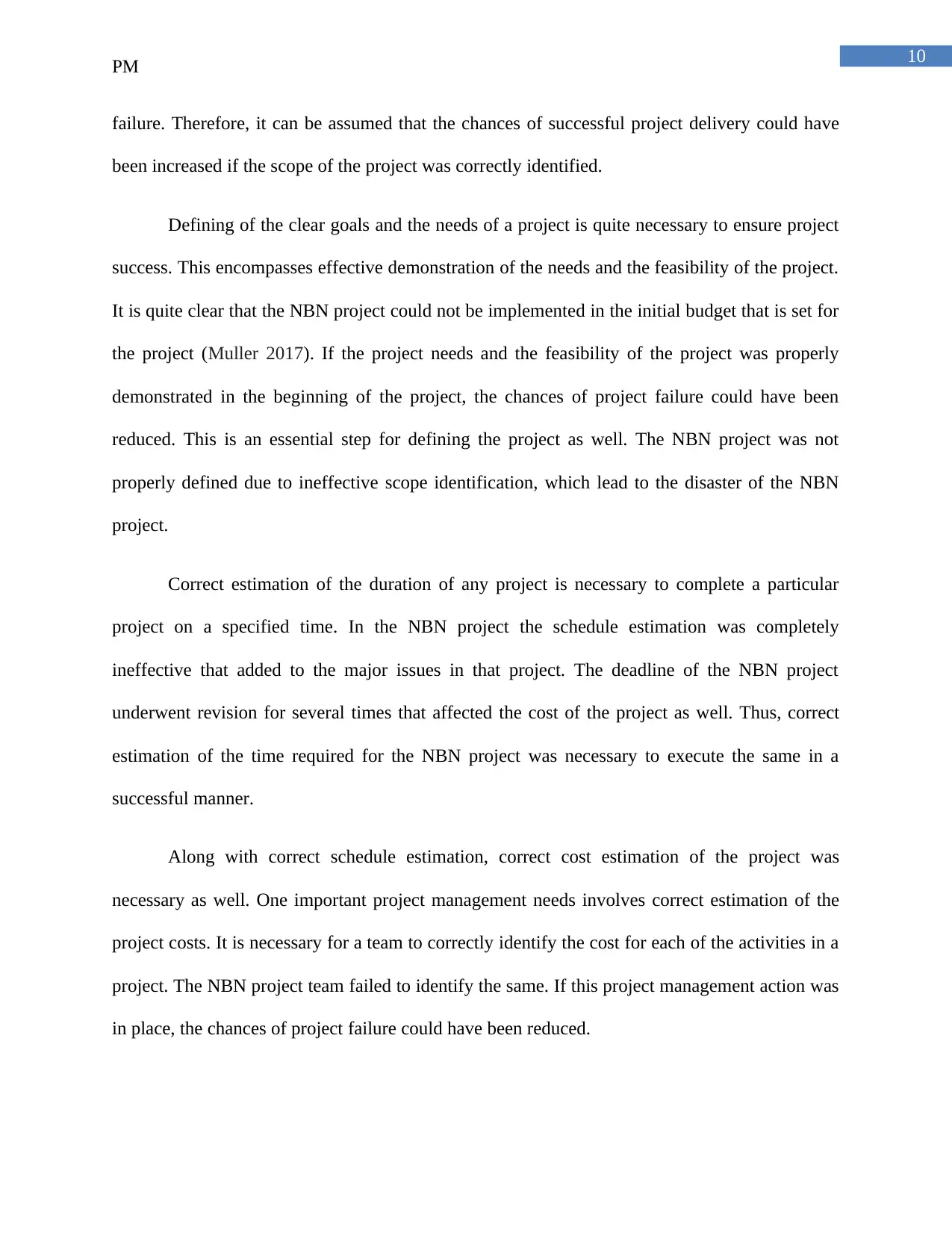
10
PM
failure. Therefore, it can be assumed that the chances of successful project delivery could have
been increased if the scope of the project was correctly identified.
Defining of the clear goals and the needs of a project is quite necessary to ensure project
success. This encompasses effective demonstration of the needs and the feasibility of the project.
It is quite clear that the NBN project could not be implemented in the initial budget that is set for
the project (Muller 2017). If the project needs and the feasibility of the project was properly
demonstrated in the beginning of the project, the chances of project failure could have been
reduced. This is an essential step for defining the project as well. The NBN project was not
properly defined due to ineffective scope identification, which lead to the disaster of the NBN
project.
Correct estimation of the duration of any project is necessary to complete a particular
project on a specified time. In the NBN project the schedule estimation was completely
ineffective that added to the major issues in that project. The deadline of the NBN project
underwent revision for several times that affected the cost of the project as well. Thus, correct
estimation of the time required for the NBN project was necessary to execute the same in a
successful manner.
Along with correct schedule estimation, correct cost estimation of the project was
necessary as well. One important project management needs involves correct estimation of the
project costs. It is necessary for a team to correctly identify the cost for each of the activities in a
project. The NBN project team failed to identify the same. If this project management action was
in place, the chances of project failure could have been reduced.
PM
failure. Therefore, it can be assumed that the chances of successful project delivery could have
been increased if the scope of the project was correctly identified.
Defining of the clear goals and the needs of a project is quite necessary to ensure project
success. This encompasses effective demonstration of the needs and the feasibility of the project.
It is quite clear that the NBN project could not be implemented in the initial budget that is set for
the project (Muller 2017). If the project needs and the feasibility of the project was properly
demonstrated in the beginning of the project, the chances of project failure could have been
reduced. This is an essential step for defining the project as well. The NBN project was not
properly defined due to ineffective scope identification, which lead to the disaster of the NBN
project.
Correct estimation of the duration of any project is necessary to complete a particular
project on a specified time. In the NBN project the schedule estimation was completely
ineffective that added to the major issues in that project. The deadline of the NBN project
underwent revision for several times that affected the cost of the project as well. Thus, correct
estimation of the time required for the NBN project was necessary to execute the same in a
successful manner.
Along with correct schedule estimation, correct cost estimation of the project was
necessary as well. One important project management needs involves correct estimation of the
project costs. It is necessary for a team to correctly identify the cost for each of the activities in a
project. The NBN project team failed to identify the same. If this project management action was
in place, the chances of project failure could have been reduced.

11
PM
One critical needs of project management involves correct identification of the major
risks in a project. The risk identification process was not correctly followed in the NBN project
leading to failure of identification of the major critical risks in the project (Joslin and Müller
2015). If proper risk management was in place, it was possible to eliminate the chances of
project failure.
Choice of a skilled project management team is necessary to ascertain its success. In
NBN project, the project team was quite ineffective that added to the causes of failure of the
NBN project. It was necessary to choose a skilled project team considering the complexity of the
project.
Thus, it can be assumed that the NBN project suffered major project management issues
while the project is being executed. If the above discussed project management processes and
actions were in place, the chances of project failure could have been reduced.
7. Conclusion
The NBN project failure indicates that effective scope identification in a project plays a
crucial role in ascertaining the project’s success. The NBN project provides major lesson learnt
processes that include understanding the need of applying proper project management
knowledge in ascertaining the project success. The NBN project establishes the importance of
appropriate schedule and cost estimation in project success. The NBN project has observed
several cost and schedule issues that contributed to its failure. The failure of the project further
established the importance of appointing a skilled project team having an experience of the
various project processes, techniques and needed tools of project management. The feasibility of
the undertaken project was not checked prior to the execution of the NBN project that lead to
PM
One critical needs of project management involves correct identification of the major
risks in a project. The risk identification process was not correctly followed in the NBN project
leading to failure of identification of the major critical risks in the project (Joslin and Müller
2015). If proper risk management was in place, it was possible to eliminate the chances of
project failure.
Choice of a skilled project management team is necessary to ascertain its success. In
NBN project, the project team was quite ineffective that added to the causes of failure of the
NBN project. It was necessary to choose a skilled project team considering the complexity of the
project.
Thus, it can be assumed that the NBN project suffered major project management issues
while the project is being executed. If the above discussed project management processes and
actions were in place, the chances of project failure could have been reduced.
7. Conclusion
The NBN project failure indicates that effective scope identification in a project plays a
crucial role in ascertaining the project’s success. The NBN project provides major lesson learnt
processes that include understanding the need of applying proper project management
knowledge in ascertaining the project success. The NBN project establishes the importance of
appropriate schedule and cost estimation in project success. The NBN project has observed
several cost and schedule issues that contributed to its failure. The failure of the project further
established the importance of appointing a skilled project team having an experience of the
various project processes, techniques and needed tools of project management. The feasibility of
the undertaken project was not checked prior to the execution of the NBN project that lead to
⊘ This is a preview!⊘
Do you want full access?
Subscribe today to unlock all pages.

Trusted by 1+ million students worldwide
1 out of 16
Related Documents
Your All-in-One AI-Powered Toolkit for Academic Success.
+13062052269
info@desklib.com
Available 24*7 on WhatsApp / Email
![[object Object]](/_next/static/media/star-bottom.7253800d.svg)
Unlock your academic potential
Copyright © 2020–2025 A2Z Services. All Rights Reserved. Developed and managed by ZUCOL.





